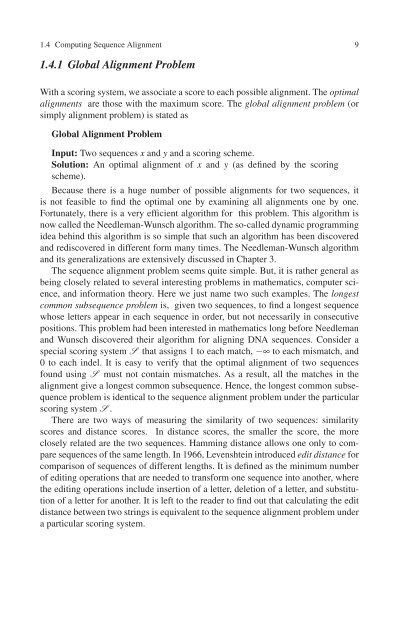You also want an ePaper? Increase the reach of your titles
YUMPU automatically turns print PDFs into web optimized ePapers that Google loves.
1.4 Computing <strong>Sequence</strong> Alignment 9<br />
1.4.1 Global Alignment Problem<br />
With a scoring system, we associate a score to each possible alignment. The optimal<br />
alignments are those with the maximum score. The global alignment problem (or<br />
simply alignment problem) is stated as<br />
Global Alignment Problem<br />
Input: Two sequences x and y and a scoring scheme.<br />
Solution: An optimal alignment of x and y (as defined by the scoring<br />
scheme).<br />
Because there is a huge number of possible alignments for two sequences, it<br />
is not feasible to find the optimal one by examining all alignments one by one.<br />
Fortunately, there is a very efficient algorithm for this problem. This algorithm is<br />
now called the Needleman-Wunsch algorithm. The so-called dynamic programming<br />
idea behind this algorithm is so simple that such an algorithm has been discovered<br />
and rediscovered in different form many times. The Needleman-Wunsch algorithm<br />
and its generalizations are extensively discussed in Chapter 3.<br />
The sequence alignment problem seems quite simple. But, it is rather general as<br />
being closely related to several interesting problems in mathematics, computer science,<br />
and information theory. Here we just name two such examples. The longest<br />
common subsequence problem is, given two sequences, to find a longest sequence<br />
whose letters appear in each sequence in order, but not necessarily in consecutive<br />
positions. This problem had been interested in mathematics long before Needleman<br />
and Wunsch discovered their algorithm for aligning DNA sequences. Consider a<br />
special scoring system S that assigns 1 to each match, −∞ to each mismatch, and<br />
0 to each indel. It is easy to verify that the optimal alignment of two sequences<br />
found using S must not contain mismatches. As a result, all the matches in the<br />
alignment give a longest common subsequence. Hence, the longest common subsequence<br />
problem is identical to the sequence alignment problem under the particular<br />
scoring system S .<br />
There are two ways of measuring the similarity of two sequences: similarity<br />
scores and distance scores. In distance scores, the smaller the score, the more<br />
closely related are the two sequences. Hamming distance allows one only to compare<br />
sequences of the same length. In 1966, Levenshtein introduced edit distance for<br />
comparison of sequences of different lengths. It is defined as the minimum number<br />
of editing operations that are needed to transform one sequence into another, where<br />
the editing operations include insertion of a letter, deletion of a letter, and substitution<br />
of a letter for another. It is left to the reader to find out that calculating the edit<br />
distance between two strings is equivalent to the sequence alignment problem under<br />
a particular scoring system.

















